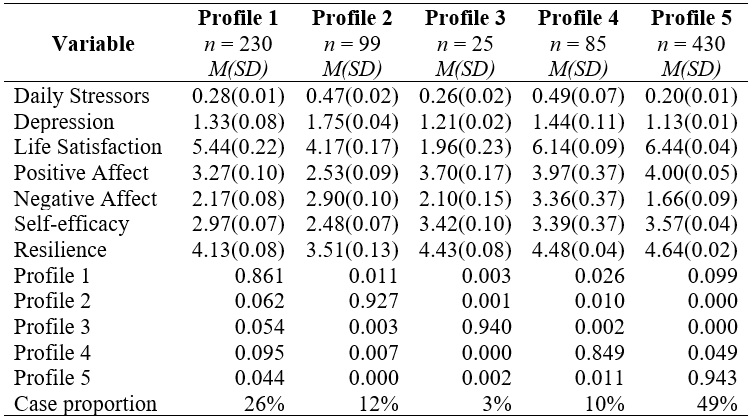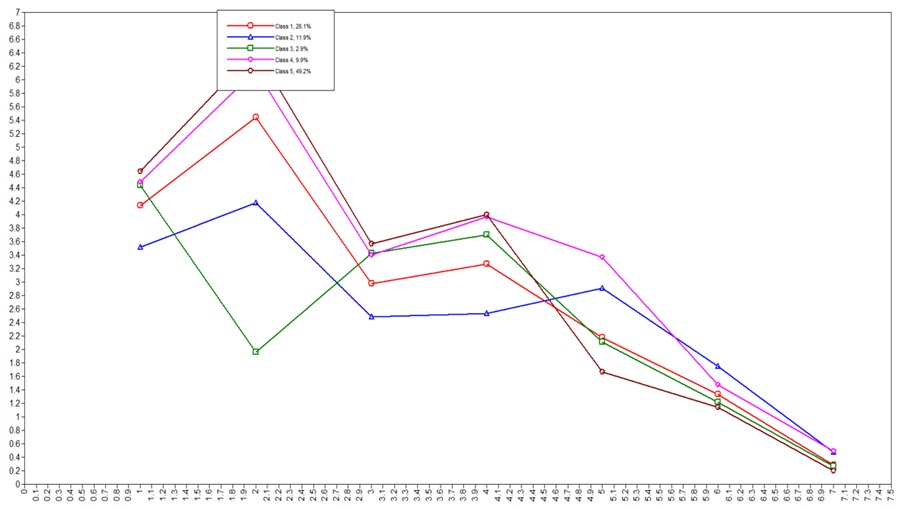We would like to thank the authorities of the
different institutions and the participants in this study for their support. This
study received specific funding from public sector agencies, commercial or
non-profit organizations.
Achterhof, R., Huntjens, R. J. C., Meewisse, M. L., & Kiers, H. A. L. (2019). Assessing the application of latent class and latent profile analysis for evaluation the construct validity of complex posttraumatic stress disorder: cautions and limitations. European Journal of Psychotraumatology, 10(1), 1-11. https://doi.org/10.1080/20008198.2019.1698223
Agudelo Hernández, F., Benavides Bastidas, M., & Arango Gómez, F. (2023). Resilience, adverse childhood experiences, and mental health in Health Science students during the Covid-19 pandemic. Salud Mental, 46(2), 111-119. https://doi.org/10.17711/SM.0185-3325.2023.015
Alfaro, J., Guzmán, J., Sirlopú, D., García, C., Reyes, F., & Gaudlitz, L. (2016). Propiedades psicométricas de la Escala de Satisfacción con la Vida en los Estudiantes (SLSS) de Huebner en niños y niñas de 10 a 12 años de Chile. Anales de Psicología, 32(2), 383-392. https://doi.org/10.6018/analesps.32.2.217441
Álvarez-Voces, M., & Romero, E. (2024). Gender differences in children’s conduct problems: A multigroup analysis of latent profiles based on temperament and psychopathic traits. Psicothema, 36(1), 26-35. https://doi.org/10.7334/psicothema2023.44
Albor-Chadid, L., Atencia, C., Castañeda, M., Fontalvo-Ariza, M. A., Gómez-Diaz, S. L., Rincón, A. M., & Pertuz, A. (2022). Bienestar psicológico y satisfacción personal en la comunidad infantil durante la pandemia del covid-19. Tejidos Sociales, 4(1), 1-10. https://revistas.unisimon.edu.co/index.php/tejsociales/article/view/5554
Anguas Plata, A. M. (2005). Bienestar subjetivo en México. Un enfoque etnopsicológico. En E. L. Garduño, A. B. Salinas y H. M. Rojas (Eds.). Calidad de Vida y bienestar subjetivo en México (pp. 167-196). Plaza y Valdés: México.
de Andrade, J. E., Meireles, A. L., Machado, E. L., de Oliveira, H. N., Sales, A. D. F., Cardoso, C. S., de Freitas, E. D., Vidigal, F. C., Ferreira, L. G., Lobre, L. N., da Silva, L. S., Reis, E. A., Saunders, R., Barbosa, B. C. R., & Ruas, C. M. (2024). Sociodemographic, economic, and academic factors linked with resilience in university students during covid-19 pandemic: a Brazilian cross-sectional study. BMC Psychology, 12(1), 1-12. https://doi.org/10.1186/s40359-024-02138-1
Araújo, A. M., Assis Gomes, C.M., Almeida, L.S., & Núñez, J.C. (2018). A latent profile analysis of first-year university student’s academic expectations. Anales de Psicología, 35(1), 58-67. https://doi.org/10.6018/analesps.35.1.299351
Asociación Americana de Psicología. (APA) (2020). Manual de Publicaciones de la American Psychological Association. (4ª. ed.). Manual Moderno.
Atienza, F. L., Pons, D., Balaguer, I., & García-Merita, M. (2000). Propiedades psicométricas de la escala de satisfacción con la vida en adolescentes. Psichotema, 12(2), 314-319. https://www.psicothema.com/pdf/296.pdf
Baessler, J., & Schwarcer, R. (1996). Evaluación de la autoeficacia: Adaptación española de la escala de Autoeficacia General. Ansiedad y Estrés, 2(1), 1-8. https://www.ansiedadyestres.es/sites/default/files/rev/ucm/1996/anyes1996a1.pdf
Baird, B. M., Lucas, R. E., & Donnellan, M. B. (2010). Life satisfaction across the lifespan: Findings from two nationally representative panel studies. Social Indicators Research, 99(1), 183-203. https://doi.org/10.1007/s11205-010-9584-9
Barcelata, B. E. (2015). Adolescentes en riesgo. Una mirada a partir de la resiliencia. Manual Moderno
Berlin, K. S., Williams, N. A., & Parra, G. R. (2014). An introduction to latent Variable Mixture Modeling (Part 1): Overview and cross-sectional latent class and latent profile analyses. Journal of Pediatric Psychology, 39(2), 174-187. https://doi.org/10.1093/jpepsy/jst084
Block, J. H., & Block, J. (1982). The role of ego-control and ego-resiliency in the organization of behavior. In W.A. Collins (Ed.), Development of cognition, affect and social relations: The Minnesota Symposia on child psychology (Vol. 13, pp. 39-101). Hillsdale, N.J. Erbaum.
Bonanno, G. A., Westphal, M., & Mancini, A. D. (2011). Resilience to loss and potential trauma. Annual Review of Clinical Psychology, 7, 511-535. https://doi.org/10.1146/annurev-clinpsy-032210-104526
Bohlmeijer, E.T., Bolier, L., Lamers, S.M.A., & Westerhof, G.J. (2017). Intervenciones clínicas positivas: ¿Por qué son importantes y cómo funcionan? Papeles del Psicólogo, 38(1), 34-46. https://doi.org/10.23923/pap.psicol2017.2819
Carrillo Punina, A., Galarza Torres, S., & García Osorio, N. (2016). Felicidad y bienestar subjetivo: factores determinantes. Economía y Negocios, 7(1), 5-14. https://www.redalyc.org/pdf/6955/695576684001.pdf
Chen, Ch., & Tang, S. (2021). Profiles of grief, post-traumatic stress, and post-traumatic growth among people bereaved due to Covid-19. European Journal of Psychotraumatology, 12(1). https://doi.org/10.1080/20008198.2021.1947563
Davanzo, P., Kerwin, L., Nikore, V., Esparza, C., Forness, S., & Murelle, L. (2004). Spanish translation and reliability testing of the Child Depression Inventory. Child Psychiatry and Humane Development, 35(1), 75-92. https://doi.org/10.1023/b:chud.0000039321.56041.cd
Del Valle, M., Vergara, J., Bernardo, A. B., Díaz, A., & Herrera, I. G. (2019). Estudio de perfiles motivacionales latentes asociados con la satisfacción y autoeficacia académica de estudiantes universitarios. Revista Iberoamericana de Diagnóstico y Evaluación. RIDEP, 57(4), 137-147. https://doi.org/10.21865/RIDEP57.4.10
Díaz-Loving, R., González-Arratia, L. F. N. I., Torres Muñoz, M.A., & Villanueva Bustamante, M. (2022). Determinantes del bienestar subjetivo en Adultos mexicanos durante el primer periodo de confinamiento por Covid-19. Revista Iberoamericana de Psicología, 15(1), 91-102. https://doi.org/10.33881/2027-1786.rip.15109
Diener, E., Emmons, R. A., Larsen, R. J., & Griffin, S. (1985). The Satisfaction with Life Scale. Journal of Personality Assessment, 49(1), 71-75. http://doi.org/10.1207/s15327752jpa4901_13
Diener, E. (2009). Culture and well-being. Springer.
Donnellan, M. B., & Robins, R. W. (2010). Resilient, overcontrolled, and undercontrolled personality types: Issues and controversies. Social and Personality Psychology Compass, 4(11), 1070-1083. https://doi.org/10.1111/j.1751-9004.2010.00313.x
Erdfelder, E., Faul, F., & Buchner, A. (1996). GPOWER: A general power analysis program. Behavior Research Methods, Instruments, & Computers, 28, 1-11. https://doi.org/10.3758/BF03203630
Ferguson, S. L., & Hull, D. M. (2018). Personality profiles: using latent profile analysis to model personality typologies. Personality and Individual Differences, 122(1), 177-183. https://doi.org/10.1016/j.paid.2017.10.029
Folke, S., Nielsen, A. B. S., Andersen, S. B., Karatzias, T., & Karstoft, K. I. (2019). ICD-11 PTSD and complex PTSD in treatment-seeking Danish veterans: a latent profile analysis. European Journal of Psychotraumatology, 10(1). https://doi.org/10.1080/20008198.2019.1686806
Gifre, M. M., del Valle, G. A., Yuguero, R. M., Gil, O. A., & Monreal, B. P. (2010). La mejora de la calidad de vida de las personas con lesión medular: la transición del centro rehabilitador a la vida cotidiana desde la perspectiva de los usuarios. Athenea Digital Revista de Pensamiento e Investigación Social, 18(1), 3-15. https://doi.org/10.5565/rev/athenead/v0n18.708
González-Arratia Lopez-Fuentes, N. I. (2016). Resiliencia y Personalidad en niños y adolescentes. Cómo desarrollarse en tiempos de crisis. Ediciones EON y Universidad Autónoma del Estado de México.
González-Arratia López-Fuentes, N. I., & Valdez Medina, J. L. (2011). Resiliencia y personalidad en adultos. Revista Electrónica de Psicología Iztacala, 14(4), 295-316. https://www.revistas.unam.mx/index.php/repi/article/view/28907
González-Arratia Lopez-Fuentes, N. I., & Torres Muñoz, M. A. (2022). Stress, Self-Efficacy, Resilience and happiness among Mexican emerging adults during the confinement due Covid-19. In Leontopoulou, S., Delle Fave, A. (eds) Emerging Adulthood in the COVID-19 Pandemic and Other Crises: Individual and Relational Resources. Cross-cultural advancements in Positive psychology vol. 17 (pp. 135-154). Springer. https://doi.org/10.1007/978-3-031-22288-7_9
Herzberg, P.Y., & Roth, M. (2006). Beyond resilients, undercontrollers, and overcontrollers? An extension of personality prototype research. European Journal of Personality, 20(1), 5-28. https://doi.org/10.1002/per.557
Horesh, D., & Brown, A. D. (2020). Traumatic stress in age of COVID-19: A call to close critical gaps and to new realities. Psychological Trauma: theory, research practice and policy, 12(4), 331-335. https://doi.org/10.1037/tra0000592
IBM (2016). IBM SPSS Statistics 24.0 [software de cómputo]. Armonk. NY: IBM Corp.
Infurna, F. J., & Luthar, S. S. (2017). The multidimensional nature of resilience to spousal loss. Journal of Personality and Social Psychology, 112(6), 926-947. https://doi.org/10.1037/pspp0000095
Janitra, F. T., Jen, H. J., Chu, H., Chen, R., Pien, L. C., Liu, D., Lai, Y. J., Banda, J. K., Lee, T. Y., Lin, H. C., Chang, C, Y., & Chou, R. K., (2023). Global prevalence of low resilience among the general population and health professionals during the Covid-19 pandemic: A meta-analysis. Journal of Affective Disorders, 332(1), 29-46. https://doi.org/10.1016/j.jad.2023.03.077
Jeffrey, H., & Yamagishi, H. (2024). Identifying post-traumatic stress symptom typologies in clinical and no-clinical healthcare staff: a latent profile analysis. European Journal of Psychotraumatology, 15(1), 1-13. https://doi.org/10.1080/20008066.2024.2351323
Kovacs, M. (1992). Children’s Depression Inventory CDI Manual. Multi-Health Systems.
Luszczynska, A., Gibbons, F. X., Piko, B. F. & Tekozel, M. (2004). Self-regulatory cognitions, social comparison, and perceived peers' behaviors as predictors of nutrition and physical activity: A comparison among adolescents in Hungary, Poland, Turkey, and USA. Psychology and Health, 19(5), 577-593. https://doi.org/10.1080/0887044042000205844
Lozano-Díaz, A., Fernández-Prados, J. S., Figueredo-Canosa, V., & Martínez-Martínez, A. M. (2020). Impactos del confinamiento por el COVID-19 entre universitarios: Satisfacción Vital, Resiliencia y Capital Social Online. International Journal of Sociology of Education, 8(4), 79-104. http://doi.org/10.17583/rise.2020.5925
Huenca, P. A. N. (2013). Estresores cotidianos y su relación con el afrontamiento en niños de 8-12 años del hogar José Soria de La Paz. Revista de Investigación Psicológica, 9, 95-104.
McCrae, R. R., & Costa, P. T. (1991). Adding liebe und arbeit: The full five factor model and well-being. Personality and Social Psychology Bulletin 17(2), 227–232. https://doi.org/10.1177/014616729101700217
Marenco-Escuderos, A. D., Cervantes, C. R., & Rambal-Rivaldo, L.I. (2023). Perfiles de resiliencia asociados al engagement académico y al apoyo social en estudiantes universitarios. Interdiscipinaria, 40(2), 231-243. http://doi.org/10.16888/interd.2023.40.2.14
Masten, A. S. (2001). Ordinary magic. Resilience Processes in Development. American Psychologist. 56(3), 227–238. https://doi.org/10.1037/0003-066X.56.3.227
Masten, A. S., & Narayan, A. J. (2012). Child development in the context of disaster, war, and terrorism: Pathways of risk and resilience. Annual Review of Psychology, 63, 227-257. https://doi.org/10.1146/annurev-psych-120710-100356
Merz, E. L., & Roesch, S. C. (2011). A latent profile analysis of the five-factor model of personality: Modeling trait interactions. Personality and Individual Diffferences, 51(8), 915-919. https://doi.org/10.1016/j.paid.2011.07.022.
Murayama, K. Usami, S., & Sakaki, M. (2022). Summary-statistics-based power analysis: A new and practical method to determine sample size for mixed-effects modeling. Psychological Methods, 27(6), 1014-1038. https://doi.org/10.1037/met0000330
Muthén, L. K., & Muthén, B. O. (2017). Mplus: Statistical analysis with latent variables, user's guide (8a ed.) [Software computacional]. https://www.statmodel.com/html_ug.shtml.
Núñez, A., Álvarez-García, D., & Pérez-Fuentes, M. (2021). Ansiedad y autoestima en los perfiles de cibervictimización de los adolescentes. Comunicar, Revista Científica de Educomunicación, 67, 47-59. https://doi.org/10.3916/C67-2021-04
Orpinas, P., Raczynki, K., Peters, J. W., Colman, L., & Bandalos, D. (2015). Latent profile analysis of sixth graders based on teacher ratings: association with school dropout. School Psychology Quarterly, 30(4), 577-592. https://doi.org/10.1037/spq0000107
Qvortrup, J. (1993). Nine Theses about Childhood as a Social Phenomenon. En J. Qvortrup (Ed.), Chilhood as a social phenomenon: Lessons from an international project (pp. 11-18). Eurosocial report, 47. Vienna European Centre.
Quezadas Barahona, A. L., Baeza Sosa, E., Ovando Torres, J. C., Gómez Gallardo, C. C., & Bracqbien Noygues, C. S. (2023). Educación para la resiliencia, un análisis desde la perspectiva de niñas, niños y docentes. Revista latinoamericana de Estudios Educativos, 53(1), 155-177. https://doi.org/10.48102/rlee.2023.53.1.534
Robins, R. W., John, O. P., Caspi, A., Moffitt. T. E., & Stouthamer-Loeber, M. (1996). Resilient, overcontrolled, and undercontrolled boys: Three replicable personality types. Journal of Personality and Social Psychology, 70(1), 157-171. https://doi.org/10.1037/0022-3514.70.1.157
Saavedra, E. (2011). Perfil de resiliencia en jóvenes de un liceo de alta vulnerabilidad de la séptima región. Revista académica de la Universidad Católica de Maule, 38, 99-117. http://web.a.ebscohost.com/ehost/detail/detail?vid=12&sid=9ca9013a-c4e8-4e64-8344-cbc57474b256%40sessionmgr4001&hid=4106&bdata=Jmxhbmc9ZXM%3d#db=fua&AN=78401469
Sette Galinari, L., & Resende Bazon, M. (2024). Necessidades de intenção diferenciadas de acordo com o modelo risco-necessidade-responsividade: Evidéncias de uma tipología empírica de adolescentes infratores brasileiros. Revista de Psicología, 43(1), 515-555. https://doi.org/10.18800/psico.202501.018
Specht, J., Luhmann, M., & Geiser, C. (2014). On the consistency of personality types across adulthood: latent profile analyses in two large-scale panel studies. Journal Personality and Social Psychology, 107(3), 540-556. http://doi.org/10.1037/a0036863
Shin, Y., Nam, J. K., Lee, A., & Kim, Y. (2023). Latent profile analysis of post-traumatic stress and post-traumatic growth among firefighters. European Journal of Psychotraumatology, 14(1), 1-15. https://doi.org/10.1080/20008066.2022.2159048
Steca, P., Alessandri, G., & Caprara, G. (2010). The utility of a well-known personality typology in studying successful aging: Resilients, undercontrollers, and overcontrollers in old age. Personality and Individual Differences, 48(4), 442-446. https://doi.org/10.1016/j.paid.2009.11.016
Soriano, J., & Monsalve, V. (2019). Perfiles de personalidad y resiliencia en dolor crónico: utilidad del CDRISC-10 para discriminar los tipos resiliente y vulnerable. Revista de la Sociedad Española del Dolor, 26(2), 72-80. http://doi.org/10.20986/resed.2018.3670/2018
Suriá Martínez, R., García Fernández, J. M., & Ortigosa Quiles, J. M. (2015). Perfiles resilientes y su relación con las habilidades sociales en personas con discapacidad motora. Behavioral Psychology/ Psicología Conductual, 23(1), 35-49. https://www.behavioralpsycho.com/wp-content/uploads/2018/10/03.Suria_23-1.pdf
Tran, A., Bianchi, V., Moeck, E. K., Clarke, B., Moore, I., Burney S. J. H., Koval, P., Kalokerinos, E. K., & Greenaway, K. H. (2023). Dynamics of social experiences in the context of extended lockdown. Social Psychological and Personality Science, 15(4), 395-406.
https://doi.org/10.1177/19485506231176603
Tonon, G. (2001). Maltrato infantil intrafamiliar, una propuesta de intervención. Espacio Editorial: Buenos Aires.
Torres, M. V. T., Mena, M. J. B., Baena, F. J. F., Espejo, M. E., Montero, E. F. M. & Sásnchez, A. M. M. (2009). Evaluación del estrés infantil: Inventario de Estresores cotidianos (IIEC). Psicothema, 21(4), 598-603. https://www.psicothema.com/pdf/3677.pdf
Várguez Pasos, L. A. (2023). Bienestar subjetivo en sectores populares de Mérida. Editorial y Servicios Culturales el Dragón Rojo: Ciudad de México.
Verdugo, M. A., & Sabeh, E. N. (2002). Evaluación de la percepción de calidad de vida en la infancia. Psicothema, 14(1), 86–91. https://reunido.uniovi.es/index.php/PST/article/view/7942
Watson, D., Clark, L. A., & Tellegen, A. (1988). Development and validation of brief measures of positive and negative affect: The PANAS scales. Journal of Personality and Social Psychology, 54(6), 1063–1070. https://doi.org/10.1037/0022-3514.54.6.1063
Yamamoto-Furusho, J. K., Gutiérrez, K. E. B., Sarmiento-Aguilar, A., Fresán-Orellana, A., Arguelles-Castro, P. & García-Alanís, M. (2021). Depression and anxiety disorders impact in the quality of life of patients with inflammatory bowel disease. Psychiatry Journal. 2021(1), 1-7. https://doi.org/10.1155/2021/5540786













